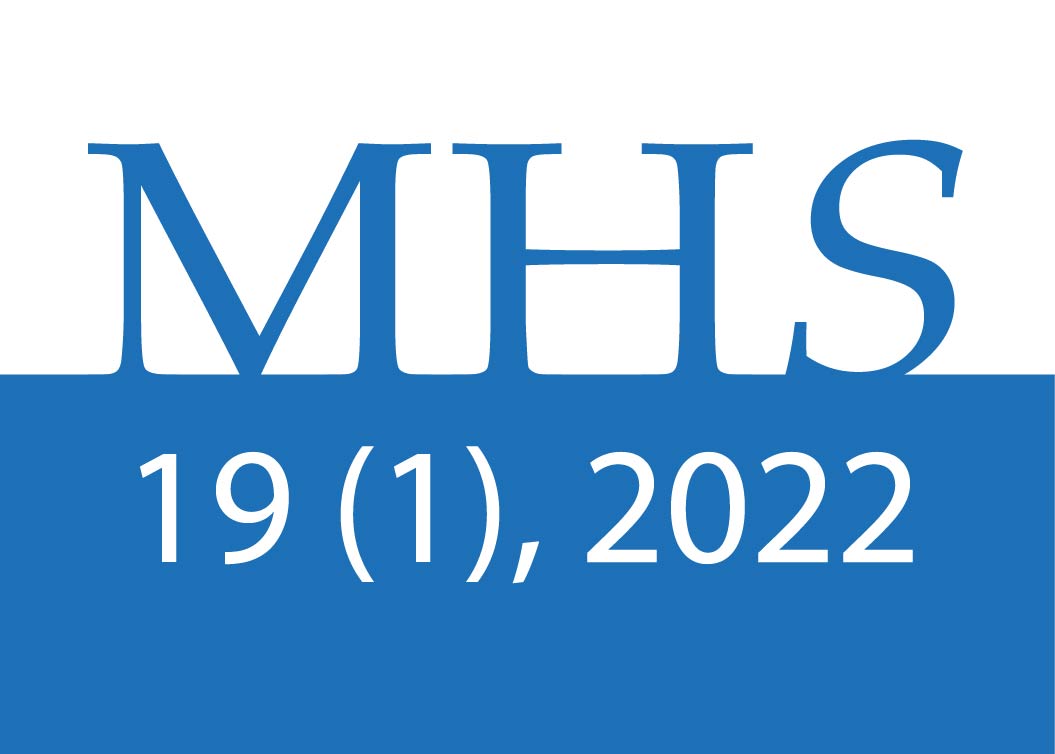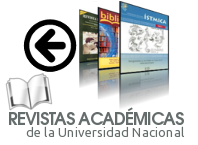Procesos de percepción auditiva y aprendizaje motor. Revisión bibliográfica
DOI:
https://doi.org/10.15359/mhs.19-1.7Palabras clave:
percepción auditiva, aprendizaje, equilibrio posturalResumen
Introducción: A nivel neurofisiológico el cerebelo, los ganglios basales y el sistema límbico son importantes en la coordinación y memoria del movimiento. Objetivo: Comprender los procesos que intervienen en la relación sensoperceptiva de la audición y el aprendizaje motor es una motivación permanente de diferentes disciplinas. Método: Se presenta una revisión documental que tuvo por objetivo analizar la relación de la percepción auditiva y el aprendizaje motor utilizando análisis de contenido desde las perspectivas de audiología, medicina y neurorrehabilitación. Las palabras clave y combinaciones que se tuvieron en cuenta fueron: percepción auditiva, aprendizaje, equilibrio, coordinación y las combinaciones audición-aprendizaje, audición-equilibrio, y audición-coordinación. Se utilizaron las bases de datos y metabuscadores Pubmed, Medscape, Trip, ScienceDirect, EBSCOhots, Pedro, Scielo, y Lilacs. Bibliotecas virtuales como SINAB, Cochrane, Universidad de Málaga, UsNational Library of Medicine, y National Institutes of Health. Se seleccionaron 22 artículos que cumplieron con los criterios de inclusión. Resultados: Se encontró relación entre la percepción auditiva y el aprendizaje motor en la comunicación de la información sensorial auditiva y motora a nivel del procesamiento en el cerebelo y ganglios, que es una parte fundamental en la retención y transferencia motriz. Conclusión: En el proceso del aprendizaje motor que involucra la experiencia del movimiento, proponemos la participación de la audición, mediante integrar las señales percibidas–visuales, auditivas, motrices y vestibulares– que se concretan en mejorar el aprendizaje, haciéndolo más eficaz y generando una memoria más duradera.
Referencias
Agostini, T., Righi, G., Galmonte, A. & Bruno, P. (2004). The relevance of auditory information in optimizing hammer throwers performance. Biomechanics and Sports, 473, 67-74. https://doi.org/10.1007/978-3-7091-2760-5_9
Atencio, C. A., Sharpee, T. O. & Schreiner, C. E. (2012). Receptive field dimensionality increases from the auditory midbrain to cortex. Journal of Neurophysiology, 107(10), 2594-2603. https://doi.org/10.1152/jn.01025.2011
Batalla Flores, A. (2005). Retroalimentación y aprendizaje motor: influencia de las acciones realizadas de forma previa a la recepción del conocimiento de los resultados en el aprendizaje y la retención de habilidades motrices. Dipòsit Digital de la Universitat de Barcelona. http://hdl.handle.net/2445/43053
Brainard, M. S. & Doupe, A. J. (2002). What songbirds teach us about learning. Nature, 417(6886), 351-358. https://doi.org/10.1038/417351a
Brown, R. E. (2020). Donald O. Hebb and the Organization of Behavior: 17 years in the writing. Molecular Brain, 13(1), 55. https://doi.org/10.1186/s13041-020-00567-8
Brown, R. M. & Palmer, C. (2012). Auditory-motor learning influences auditory memory for music. Memory & Cognition, 40(4), 567-578. https://doi.org/10.3758/s13421-011-0177-x
Buchanan, J. J. & Wang, C. (2012). Overcoming the guidance effect in motor skill learning: feedback all the time can be beneficial. Experimental Brain Research, 219(2), 305-320. https://doi.org/10.1007/s00221-012-3092-x
Campos, J., Ramkhalawansingh, R. & Pichora-Fuller, M. K. (2018). Hearing, self-motion perception, mobility, and aging. Hearing Research, 369, 42-55. https://doi.org/10.1016/j.heares.2018.03.025
Chacón-Cuberos, R., Zurita-Ortega, F., Ramírez-Granizo, I. & Castro-Sánchez, M. (2020). Physical Activity and Academic Performance in Children and Preadolescents: A Systematic Review. Apunts. Educación Física y Deportes, (139), 1-9. https://doi.org/10.5672/apunts.2014-0983.es.(2020/1).139.01
Dick, A. & Tremblay, P. (2012). Beyond the arcuate fasciculus: consensus and controversy in the connectional anatomy of language. Brain, 135(12), 3529-3550. https://doi.org/10.1093/brain/aws222
Effenberg, A. O. (2005). Movement sonification: effects on perception and action. IEEE Multimedia, 12(2), 53-59. https://doi.org/10.1109/mmul.2005.31
Fernández-Miranda, J. C., Wang, Y., Pathak, S., Stefaneau, L., Verstynen, T. & Yeh, F. C. (2015). Asymmetry, connectivity, and segmentation of the arcuate fascicle in the human brain. Brain Structure & Function, 220(3), 1665-1680. https://doi.org/10.1007/s00429-014-0751-7
Gandemer, L., Parseihian, G., Kronland-Martinet, R. & Bourdin, C. (2017). Spatial cues provided by sound improve postural stabilization: evidence of a spatial auditory map? Frontiers in Neuroscience, 11, 1-11. https://doi.org/10.3389/fnins.2017.00357
Gazzola, V., Aziz-Zadeh, L. & Keysers, C. (2006). Empathy and the somatotopic auditory mirror system in humans. Current Biology, 16(18), 1824-1829. https://doi.org/10.1016/j.cub.2006.07.072
Haueisen, J. & Knösche, T. R. (2001). Involuntary Motor Activity in Pianists Evoked by Music Perception. Journal of Cognitive Neuroscience, 13(6), 786-792. https://doi.org/10.1162/08989290152541449
Kramer, S. & Brown, D. K. (2021). Audiología: Ciencia a la práctica (4.a ed.). Plural Publishing, Inc.
Kennel, C., Streese, L., Pizzera, A., Justen, C., Hohmann, T. & Raab, M. (2015). Auditory reafferences: the influence of the real-time feedback on movement control. Frontiers in Psychology, 6, 1-6. https://doi.org/10.3389/fpsyg.2015.00069
Lahav, A., Saltzman, E. & Schlaug, G. (2007). Action representation of sound: audio motor recognition network while listening to newly acquired actions. Journal of Neuroscience, 27(2), 308-314. https://doi.org/10.1523/JNEUROSCI.4822-06.2007
Lin, F. R. & Ferrucci, L. (2012). Hearing loss and falls among older adults in the United States. Archives of Internal Medicine, 172(4), 369-371. https://doi.org/10.1001/archinternmed.2011.728
Meck, W. H., Penney, T. B. & Pouthas, V. (2008). Cortico-striatal representation of time in animals and humans. Current Opinion in Neurobiology, 18(2), 145-152. https://doi.org/10.1016/j.conb.2008.08.002
Mena de la Cruz, A. C. (2018). Aproximación teórica de la intervención de fisioterapia en neurorrehabilitación desde el aprendizaje motor en pacientes con evento cerebrovascular. Movimiento Científico, 11(2), 73-80. https://doi.org/10.33881/2011-7191.mct.11204
Myers, J. C., Mock, J. R. & Golob, E. J. (2020). Sensorimotor integration can enhance auditory perception. Scientific Reports, 10(1), 1-13. https://doi.org/10.1038/s41598-020-58447-z
Pérez, C., Montoya, O. L. & Henao, L. M. (2020). Aprendizaje motor y realidad virtual. En M. A. Cubillo León (Comp.), Avances científicos y nuevas tecnologías en neurorrehabilitación transdisciplinaria (pp. 119-141). CMUCH. https://bit.ly/35LTYMW
Rizzolatti, G., Fadiga, L., Gallese, V. y Fogassi, L. (1996). Premotor cortex and the recognition of motor actions. Cognitive Brain Research, 3(2), 131-141. https://doi.org/10.1016/0926-6410(95)00038-0
Ronsse, R., Puttemans, V., Coxon, J. P., Goble, D. J., Wagemans, J., Wenderoth, N. & Swinnen, S. P. (2010). Motor learning with augmented feedback: modality-dependent behavioral and neural consequences. Cerebral Cortex, 21(6), 1283-1294. https://doi.org/10.1093/cercor/bhq209
Sánchez, E. (2014). Fisiología auditiva. En J. Pérez & E. Gil (Eds.), Libro virtual de formación en ORL (1.a ed., Vol. 1, pp. 1-19). Sociedad Española de Otorrinolaringología y Patología Cérvico-Facial. https://booksmedicos.org/libro-virtual-de-formacion-en-otorrinolaringologia-seorl/
Schachner, A. (2010). Auditory-motor entrainment in vocal mimicking species. Communicative & Integrative Biology, 3(3), 290-293. https://doi.org/10.4161/cib.3.3.11708
Schmitz, G., Mohammadi, B., Hammer, A., Heldmann, M., Samii, A., Münte, T. F. & Effenberg, A. O. (2013). Observation of sonified movements engages a basal ganglia frontocortical network. BMC Neuroscience, 14(32). https://doi.org/10.1186/1471-2202-14-32
Sigrist, R., Rauter, G., Riener, R. & Wolf, P. (2013). Augmented visual, auditory, haptic, and multimodal feedback in motor learning: A review. Psychonomic Bulletin & Review, 20, 21-53. https://doi.org/10.3758/s13423-012-0333-8
Skjaerven, L. H., Mattsson, M., Catalán-Matamoros, D., Parker, A., Gard, G. & Gyllensten, A. L. (2018). Consensus on core phenomena and statements describing Basic Body Awareness Therapy within the movement awareness domain in physiotherapy. Physiotherapy Theory and Practice, 35(1), 80-93. https://doi.org/10.1080/09593985.2018.1434578
Suárez, H. & Ferreira, E. (2019). Rol de la información auditiva en el control motor del sistema del equilibrio en pacientes con implantes cocleares. Anales de la Facultad de Medicina, 6(2), 8-24. https//doi.org/10.25184/anfamed2019v6n2a10
Teki, S., Grube, M. & Griffiths, T. (2012). A unified model of time perception accounts for duration-based and beat-based timing mechanisms. Frontiers in Integrative Neuroscience, 5, 1-7. https://doi.org/10.3389/fnint.2011.00090
Vidranski, T. & Farkaš, D. (2015). Motor skills in hearing impaired children with or without cochlear implant -A systematic review. Collegium Antropologicum, 39(1), 173-179. https://bit.ly/3kuQrXI
Viljanen, A., Kaprio, J., Pyykko, I., Sorri, M., Pajala, S., Kauppinen, M., Koskenvuo, M. & Rantanen, T. (2009). Hearing as a Predictor of Falls and Postural Balance in Older Female Twins. The Journals of Gerontology Series A: Biological Sciences and Medical Sciences, 64A(2), 312-317. https://doi.org/10.1093/gerona/gln015
Descargas
Publicado
Cómo citar
Número
Sección
Licencia
Condiciones generales

MHSalud: Revista en Ciencias del Movimiento Humano y Salud por Universidad Nacional se encuentra bajo una Licencia Creative Commons Atribución-NoComercial-SinDerivadas 3.0 Costa Rica.
La revista se aloja en repositorios de acceso abierto como el Repositorio Institucional de la Universidad Nacional, el Repositorio Kimuk de Costa Rica y la Referencia.
La fuente editorial de la revista debe reconocerse. Para ello utilice el identificador doi de la publicación.
Política de autoarchivo: La revista permite el auto archivo de los artículos en su versión arbitrada, editada y aprobada por el Consejo Editorial de la Revista para que sean disponibles en Acceso Abierto a través de Internet. Más información en el siguiente link: https://v2.sherpa.ac.uk/id/publication/25815


















